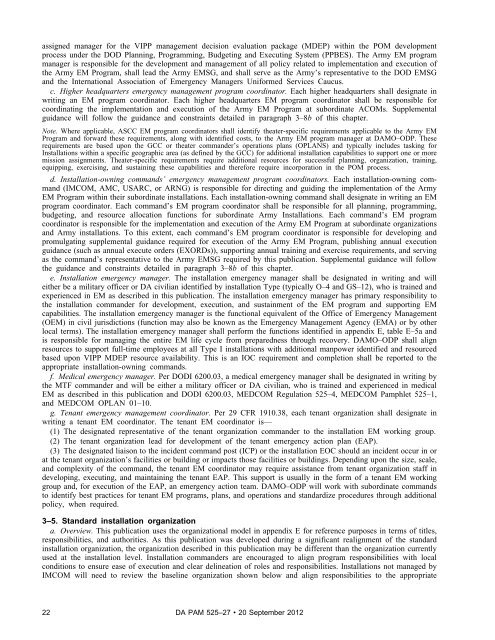Army Emergency Management Program - Federation of American ...
Army Emergency Management Program - Federation of American ...
Army Emergency Management Program - Federation of American ...
Create successful ePaper yourself
Turn your PDF publications into a flip-book with our unique Google optimized e-Paper software.
assigned manager for the VIPP management decision evaluation package (MDEP) within the POM development<br />
process under the DOD Planning, <strong>Program</strong>ming, Budgeting and Executing System (PPBES). The <strong>Army</strong> EM program<br />
manager is responsible for the development and management <strong>of</strong> all policy related to implementation and execution <strong>of</strong><br />
the <strong>Army</strong> EM <strong>Program</strong>, shall lead the <strong>Army</strong> EMSG, and shall serve as the <strong>Army</strong>’s representative to the DOD EMSG<br />
and the International Association <strong>of</strong> <strong>Emergency</strong> Managers Uniformed Services Caucus.<br />
c. Higher headquarters emergency management program coordinator. Each higher headquarters shall designate in<br />
writing an EM program coordinator. Each higher headquarters EM program coordinator shall be responsible for<br />
coordinating the implementation and execution <strong>of</strong> the <strong>Army</strong> EM <strong>Program</strong> at subordinate ACOMs. Supplemental<br />
guidance will follow the guidance and constraints detailed in paragraph 3–8b <strong>of</strong> this chapter.<br />
Note. Where applicable, ASCC EM program coordinators shall identify theater-specific requirements applicable to the <strong>Army</strong> EM<br />
<strong>Program</strong> and forward these requirements, along with identified costs, to the <strong>Army</strong> EM program manager at DAMO–ODP. These<br />
requirements are based upon the GCC or theater commander’s operations plans (OPLANS) and typically includes tasking for<br />
Installations within a specific geographic area (as defined by the GCC) for additional installation capabilities to support one or more<br />
mission assignments. Theater-specific requirements require additional resources for successful planning, organization, training,<br />
equipping, exercising, and sustaining these capabilities and therefore require incorporation in the POM process.<br />
d. Installation-owning commands’ emergency management program coordinators. Each installation-owning command<br />
(IMCOM, AMC, USARC, or ARNG) is responsible for directing and guiding the implementation <strong>of</strong> the <strong>Army</strong><br />
EM <strong>Program</strong> within their subordinate installations. Each installation-owning command shall designate in writing an EM<br />
program coordinator. Each command’s EM program coordinator shall be responsible for all planning, programming,<br />
budgeting, and resource allocation functions for subordinate <strong>Army</strong> Installations. Each command’s EM program<br />
coordinator is responsible for the implementation and execution <strong>of</strong> the <strong>Army</strong> EM <strong>Program</strong> at subordinate organizations<br />
and <strong>Army</strong> installations. To this extent, each command’s EM program coordinator is responsible for developing and<br />
promulgating supplemental guidance required for execution <strong>of</strong> the <strong>Army</strong> EM <strong>Program</strong>, publishing annual execution<br />
guidance (such as annual execute orders (EXORDs)), supporting annual training and exercise requirements, and serving<br />
as the command’s representative to the <strong>Army</strong> EMSG required by this publication. Supplemental guidance will follow<br />
the guidance and constraints detailed in paragraph 3–8b <strong>of</strong> this chapter.<br />
e. Installation emergency manager. The installation emergency manager shall be designated in writing and will<br />
either be a military <strong>of</strong>ficer or DA civilian identified by installation Type (typically O–4 and GS–12), who is trained and<br />
experienced in EM as described in this publication. The installation emergency manager has primary responsibility to<br />
the installation commander for development, execution, and sustainment <strong>of</strong> the EM program and supporting EM<br />
capabilities. The installation emergency manager is the functional equivalent <strong>of</strong> the Office <strong>of</strong> <strong>Emergency</strong> <strong>Management</strong><br />
(OEM) in civil jurisdictions (function may also be known as the <strong>Emergency</strong> <strong>Management</strong> Agency (EMA) or by other<br />
local terms). The installation emergency manager shall perform the functions identified in appendix E, table E–5a and<br />
is responsible for managing the entire EM life cycle from preparedness through recovery. DAMO–ODP shall align<br />
resources to support full-time employees at all Type I installations with additional manpower identified and resourced<br />
based upon VIPP MDEP resource availability. This is an IOC requirement and completion shall be reported to the<br />
appropriate installation-owning commands.<br />
f. Medical emergency manager. Per DODI 6200.03, a medical emergency manager shall be designated in writing by<br />
the MTF commander and will be either a military <strong>of</strong>ficer or DA civilian, who is trained and experienced in medical<br />
EM as described in this publication and DODI 6200.03, MEDCOM Regulation 525–4, MEDCOM Pamphlet 525–1,<br />
and MEDCOM OPLAN 01–10.<br />
g. Tenant emergency management coordinator. Per 29 CFR 1910.38, each tenant organization shall designate in<br />
writing a tenant EM coordinator. The tenant EM coordinator is—<br />
(1) The designated representative <strong>of</strong> the tenant organization commander to the installation EM working group.<br />
(2) The tenant organization lead for development <strong>of</strong> the tenant emergency action plan (EAP).<br />
(3) The designated liaison to the incident command post (ICP) or the installation EOC should an incident occur in or<br />
at the tenant organization’s facilities or building or impacts those facilities or buildings. Depending upon the size, scale,<br />
and complexity <strong>of</strong> the command, the tenant EM coordinator may require assistance from tenant organization staff in<br />
developing, executing, and maintaining the tenant EAP. This support is usually in the form <strong>of</strong> a tenant EM working<br />
group and, for execution <strong>of</strong> the EAP, an emergency action team. DAMO–ODP will work with subordinate commands<br />
to identify best practices for tenant EM programs, plans, and operations and standardize procedures through additional<br />
policy, when required.<br />
3–5. Standard installation organization<br />
a. Overview. This publication uses the organizational model in appendix E for reference purposes in terms <strong>of</strong> titles,<br />
responsibilities, and authorities. As this publication was developed during a significant realignment <strong>of</strong> the standard<br />
installation organization, the organization described in this publication may be different than the organization currently<br />
used at the installation level. Installation commanders are encouraged to align program responsibilities with local<br />
conditions to ensure ease <strong>of</strong> execution and clear delineation <strong>of</strong> roles and responsibilities. Installations not managed by<br />
IMCOM will need to review the baseline organization shown below and align responsibilities to the appropriate<br />
22 DA PAM 525–27 20 September 2012
















